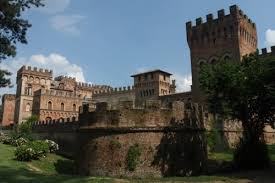Isola Dovarese is a borough in the Po Valley with an interesting history. Isola, or “Insula”, as some ancient documents refer to it, rises on a little drop-shaped terrace of land on the Oglio river floodplain. The water, surrounding Isola by three quarters, made it a rather important center in older times. “Dovarese” comes from the Dovara family, rulers of the area between the XIV and the XV centuries.
Crossing the arc-shaped gate, one enters the “contrada” of Porta Tenca: a contrada used to be a geographical subdivision within the same town or city. A few steps ahead, one can see the main church, dedicated to St. Nicola from Bari, protector of water. The church contains beautiful paintings, among which “The Annunciation”, attributed to either AltobelloMelone or Gianfranco Bembo, “Ecce Homo” by Bernardino Campi, and the coat of arms of the Gonzaga, visible on the main altar.
The contrada of San Giuseppe hosts the “oratorio”, an additional site for prayer and celebration of the Mass, established in 1688. Do not be tricked by the simple façade, however: the front door will reveal a nave full of frescos, which form a sumptuous architecture through illusionistic painting.
The convent of San Bernardino, built in 1476, is located in the homonymous contrada, although only a few traces of the ancient architecture remain: it was in fact turned into a house after the monastic orders were suppressed.
Entering Isola, the liaison between the town and water becomes clear. The Oglio river flows around the residential area, highlighting the up-and-downs of the terraces formed by the water over the centuries.
Many traces of Isola’s history are left, a past that is exemplified by the large square, designed by architect Giulio Brunelleschi by order of Giulio Cesare Gonzaga and built around 1590. Its size, especially large for such a small town, and its position at the center of Isola, make it one of the most important examples of Gonzaga-style Renaissance architecture. A large arc-shaped gate can be observed on the longer side of the square: this is what remains of a preexisting construction. It was probably an access to the open-space before the “rocca”, a kind of fortress, which used to be located where the elementary school is now. The old prison can still be visited inside Palazzo Pretorio, currently the town hall.
LA GRANDE @TTRAZIONE
Our restaurant is part of “La Grande @ttrazione” (i.e. The Great Attraction), a UNESCO project. The initiative is ideal for those who love culture and want to get to know better the Heritage of Humanity conserved in the area around Brescia, Cremona, Mantua, and Sabbioneta.
You can see the cultural sites recognized by UNESCO at: www.grandeattrazione.it. Alternatively, you can download the map and the app to find out about the routes – don’t miss the audioguides of the tours!
You can
also play a game through the “gamification Grande @ttrazione”: the more
Heritage of Humanity sites you visit, the more points you gain and the higher
your position in the special ranking of La Grande @ttrazione”.
AROUND THE AREA
Isola Dovarese rises in a strategic position, close to the cities of Cremona (25km), Brescia (41km), and Mantua (38 km). Lake Garda, the largest lake in Italy, is also not far (37km). Isola is also surrounded by unique boroughs: passing from Isola, the town ofSabbioneta is a must-go, together with the castles and villas of Torre de’ Picenardi and San Giovanni in Croce: this last was home of Cecilia Gallerani, painted by Leonardo da Vinci in his stunning “The Lady with an Ermine”.










